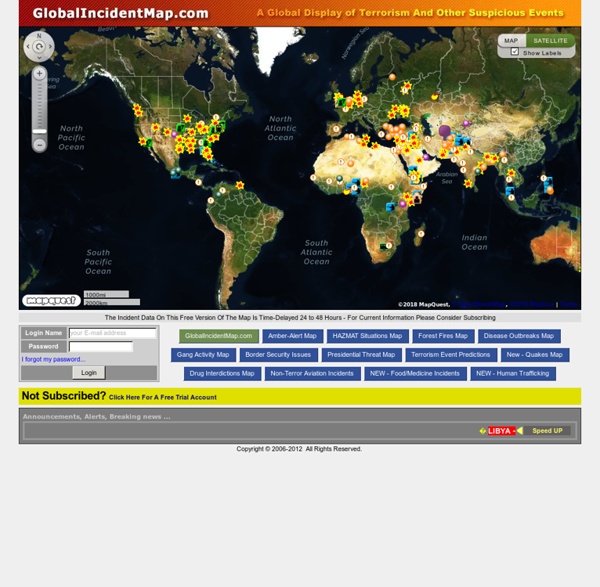



Webcam Directory | Weather Underground report this ad why ads? Weather Webcams Add Your Webcam My Webcams Webcam Directory View weather around the globe, as it happens. The map below shows the 50 most recently updated cams. By U.S. By Country (17334) Map data ©2016 Google, INEGI Terms of Use Map Satellite Link to Current View Select a state in the Active Webcams menu to display local cameras. 4,342,482 images uploaded today. 452,220 videos created today. Add Your Webcam Share your webcam with the world! Do you have a webcam that you'd like to add to our site? View an example of a weather station with RapidFire and webcam enabled. Add Your Webcam! Ads help us bring you the weather for free. For less than a dollar a month ($10/yr) you can sign up for a premium membership and remove ads. Remove Ads
OSINT Training by Michael Bazzell The Asian Media Information and Communication Centre (AMIC) - Singapore Portal Une planète antiterroriste OWNI a développé avec RFI une application qui recense les législations antiterroristes dans le monde. Justice d'exception, surveillance accrue, alibi pour les États autoritaires. Triste panorama de trois décennies d'antiterrorisme. Cette application interactive (faites glisser la barre chronologique, cliquez sur les pays etc…) a été développée par OWNI en partenariat avec RFI. L’application ci-dessus permet de naviguer dans les lois antiterroristes votées dans le monde, au lendemain d’attentats, 11 septembre ou autres. Comme le montrent les couleurs de la frise chronologique sur l’application, les années post-11 septembre ont connu un accroissement exponentiel des dispositifs de lutte antiterroriste. En 1996 est introduit un nouveau délit, “l’association de malfaiteur en relation avec une entreprise terroriste”, clé de voûte de l’antiterrorisme à la française, fondé sur la justice préventive. Au cœur des années de plomb, l’Italie s’était déjà dotée d’une législation antiterroriste. Alibi
Coastal Risk Australia RBI: Reddit Bureau of Investigation: Using the power of Reddit to solve real world crimes MapMaker Interactive Welcome to the MapMaker Interactive This tutorial explains how to explore National Geographic Education's interactive GIS mapping tool and tools for customizing outline maps for print. Use the zoom bar to go from a world view to a local view (or in cartographic terms, from a large scale to a small scale). If you zoom out to a world view, you will see that the map is in a Mercator projection. Use the location menus at the top to zoom from a world view to a continent, country, or other region. Identify your geographic position on the map using the latitude and longitude display at the bottom left. Switch between different styles of base maps including a custom layer from National Geographic, satellite, terrain, and topographic views. Using the 1-Page base map, click on a continent, country, or state to load the corresponding MapMaker 1-Page map. You can customize and download your 1-Page map, or go back to the interactive map to explore more.
L’Assemblée élit le Guatemala, le Maroc, le Pakistan et le Togo Assemblée générale Soixante-sixième session 37e et 38e séances plénières – matin & après-midi Elle ne parvient pas à départager l’Azerbaïdjan et la Slovénie pour le siège du Groupe des États de l’Europe orientale L’Assemblée générale a élu aujourd’hui le Guatemala, le Maroc, le Pakistan et le Togo comme membres non permanents du Conseil de sécurité pour un mandat de deux ans, à compter du 1er janvier 2012. Le Guatemala, le Maroc et le Pakistan ont été élus dès le premier tour de scrutin, tandis que le Togo a été élu après trois tours. Concernant le Groupe des États d’Afrique, le Maroc a recueilli 151 voix. S’agissant du Groupe des États d’Asie-Pacifique, le Pakistan, qui a obtenu 129 voix, remplacera le Liban. Pour le Groupe des États d’Amérique latine et des Caraïbes, le Guatemala a obtenu 191 voix et remplacera le Brésil. Le huitième tour de scrutin, à nouveau restreint aux deux pays en tête du tour précédent, a vu l’Azerbaïdjan recueillir 110 voix et la Slovénie 80 voix.
International Development - NGIS This project trained 195 people from 95 organisations to enhance the capacity of Tonga, Papua New Guinea, Vanuatu and Samoa to undertake assessments of inundation exposure to key settlements and infrastructure at risk from sea level rise through the provision of critical baseline data, improved GIS capacity, and implementation of coastal inundation modelling. The software and online spatial tools delivered as part of this project enabled maps to be printed and laminated for presentations to local communities. These flood maps provided an important mechanism for informing communities of their potential risk. The online tools and maps were integrated into the education systems in each country so that the younger generation can understand the impacts of coastal inundation. Without these maps it would have been extremely difficult for the government departments to communicate the climate change risk to their citizens and communities.
Minnesota Public Criminal History - Home «Ihr konntet es mal!» Al Imfeld hat ein Buch mit afrikanischen Agrargeschichten geschrieben. Ein Gespräch mit dem Afrikaspezialisten, der am Erscheinungstag dieser WOZ seinen 75. Geburtstag feiert. Marcel Hänggi und Bettina Dyttrich WOZ: Al Imfeld, Sie schreiben mit Ihrem Buch gegen die Vorstellung an, Afrika habe keine eigene Landwirtschaft entwickelt. ... Wie definieren Sie Landwirtschaft? Sie schreiben, die diskriminierende Wahrnehmung zeige sich etwa darin, dass die Agrarforschung eine Feldfrucht wie Yams gering schätzt. Nun haben wir ja bereits ein halbes postkoloniales Jahrhundert erlebt. Auch die Gerätschaften unterscheiden sich zwischen Europa und Afrika. Aber es gibt doch heute alternative Tendenzen. In Afrika fällt immer wieder auf, dass viele Bauern und Bäuerinnen Grundlegendes nicht wissen – etwa dass Grünabfälle zur Düngung aufs Feld zurückgebracht werden sollten. Früher versorgten die Bauern vor allem die eigene Familie. Aber das war ein prekäres Können.